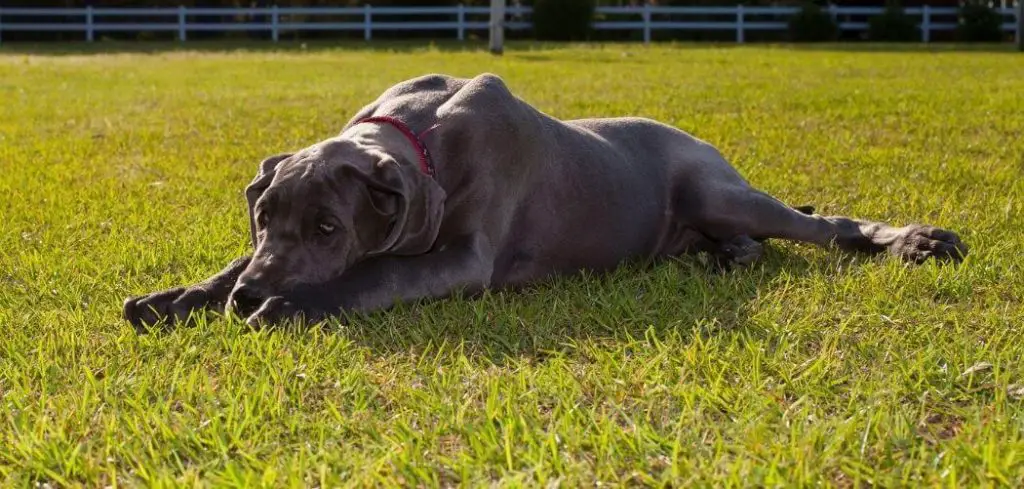Dog panting combined with an inability to move the back legs is a distressing situation for any dog owner to witness. These two symptoms appearing together can indicate a potentially serious problem that requires immediate attention.
While panting can be linked to discomfort or stress, the sudden loss of mobility in the hind legs adds urgency to the situation.
Recognizing these signs early and understanding what steps to take can make a critical difference in your dog’s health and recovery.
We outline the common reasons why your dog is panting and can’t move their back legs, what you can do at home, and when to seek veterinary help.
Table of Contents
Dog Panting and Can't Move Back Legs — Why It Happens
When a dog is panting and can’t move their back legs, this often signals distress or pain, which may stem from neurological problems, injuries, infections, or systemic diseases.
Conditions like spinal cord injury, intervertebral disc disease, and severe infections can cause these signs.
Prompt attention is crucial because these causes can progress quickly and impact your dog’s quality of life.

Dog Panting and Can’t Move Back Legs: Common Causes
Intervertebral Disc Disease (IVDD)
Intervertebral Disc Disease occurs when the cushioning discs between the vertebrae in a dog’s spine degenerate or herniate.
This can compress the spinal cord, leading to weakness or paralysis of the back legs. Dogs with IVDD often pant due to pain or distress caused by the spinal injury.
Owners might notice their dog struggling to stand or walk, reluctance to move, or sudden back pain.
This condition is serious because spinal cord compression can cause permanent nerve damage if not treated promptly.
Read more: Dog Panting and Can’t Walk (What you should do next)
Spinal Cord Injury or Trauma
Trauma from accidents, falls, or sudden injuries can cause spinal cord damage, resulting in paralysis or weakness in the back legs.
Panting may occur as a response to pain, shock, or stress from the injury.
Signs include difficulty moving the hind limbs, vocalizing in pain, or total inability to walk. Immediate veterinary care is vital, as spinal injuries can be life-threatening and require urgent intervention.
Degenerative Myelopathy
Degenerative Myelopathy is a progressive disease that affects the spinal cord, leading to gradual loss of coordination and strength in the back legs.
Although panting is not a primary symptom, it can occur due to anxiety or discomfort related to mobility challenges.
Owners may observe a slow decline in hind limb function, stumbling, and difficulty standing.
While this disease progresses slowly, it significantly affects a dog’s mobility and quality of life.
Pain and Stress from Other Illnesses
Severe pain or discomfort from other illnesses like arthritis, infections, or tumors can cause dogs to pant heavily and refuse to move their back legs due to pain.
Symptoms to watch for include swelling, reluctance to move, visible discomfort, or abnormal behavior.
Persistent pain reduces a dog’s ability to stand or walk, warranting medical evaluation to manage pain effectively.
Tick Paralysis
Tick paralysis is caused by toxins released by certain ticks, which interfere with nerve function.
can lead to rapid onset paralysis, starting from the hind legs and sometimes accompanied by panting due to respiratory distress or anxiety.
Owners might notice weakness progressing quickly to paralysis, sometimes with vomiting or coughing.
Tick paralysis requires immediate removal of the tick and veterinary treatment to prevent fatal outcomes.
Heart or Respiratory Issues
Severe heart or lung problems can cause panting due to difficulty breathing and weakness in the limbs from poor circulation or oxygen supply.
While these conditions don’t directly paralyze the back legs, weakness and collapse can occur.
Signs include coughing, labored breathing, pale gums, and collapse.
These are serious conditions that need prompt veterinary attention to stabilize the dog.
What to Do If Your Dog Is Dog Panting and Can’t Move Back Legs
If your dog is panting and unable to move their back legs, first try to keep them calm and comfortable. Avoid forcing movement, as this can worsen spinal injuries or cause pain.
Provide a quiet and supportive resting place, ensuring they don’t overheat, as panting can increase with heat stress. Offer water if your dog is alert and able to drink.
Do not attempt home remedies or exercises unless advised by a veterinarian.
Document any additional symptoms, like changes in consciousness, vomiting, or urinary problems, to inform your vet.
If you suspect a tick, carefully check and remove it using proper techniques, but still seek veterinary help promptly.
When to Call or Visit Your Vet
Seek immediate veterinary care if your dog shows any of the following signs alongside panting and inability to move back legs:
Sudden paralysis or inability to stand
Severe or worsening pain
Difficulty breathing or bluish gums
Loss of bladder or bowel control
Collapse or unconsciousness
Rapid progression of weakness
These symptoms indicate serious medical emergencies. Delaying treatment can result in permanent damage or death.
Even if the symptoms develop gradually, a veterinary assessment is important to diagnose the underlying cause and start appropriate treatment.
Read more: Dog Panting and Can’t Sleep (Here’s Why)
Key Takeaway
Dog panting combined with an inability to move their back legs is an alarming symptom that requires prompt attention.
These signs can indicate spinal injury, neurological disease, or systemic illness that may rapidly worsen without treatment.
If your dog exhibits these symptoms, keep them calm and seek veterinary care immediately.
Early diagnosis and intervention improve the chances of recovery and reduce the risk of permanent disability.
Your dog depends on you for timely help—being vigilant and responsive is the best way to protect their health and comfort.
